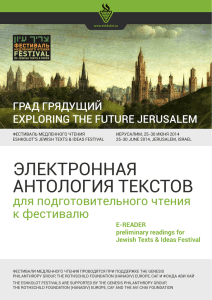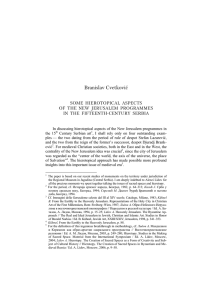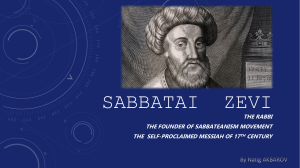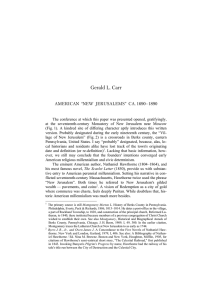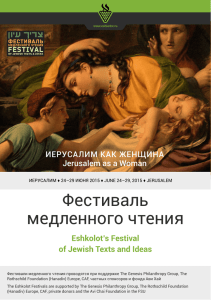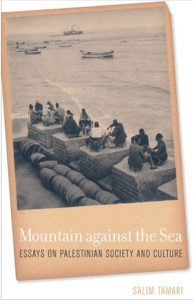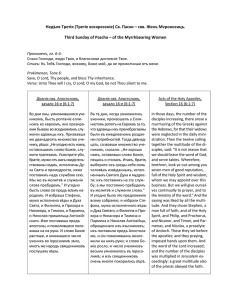Интерпретируя образ Церкви в руках апостолов Петра и Павла
реклама
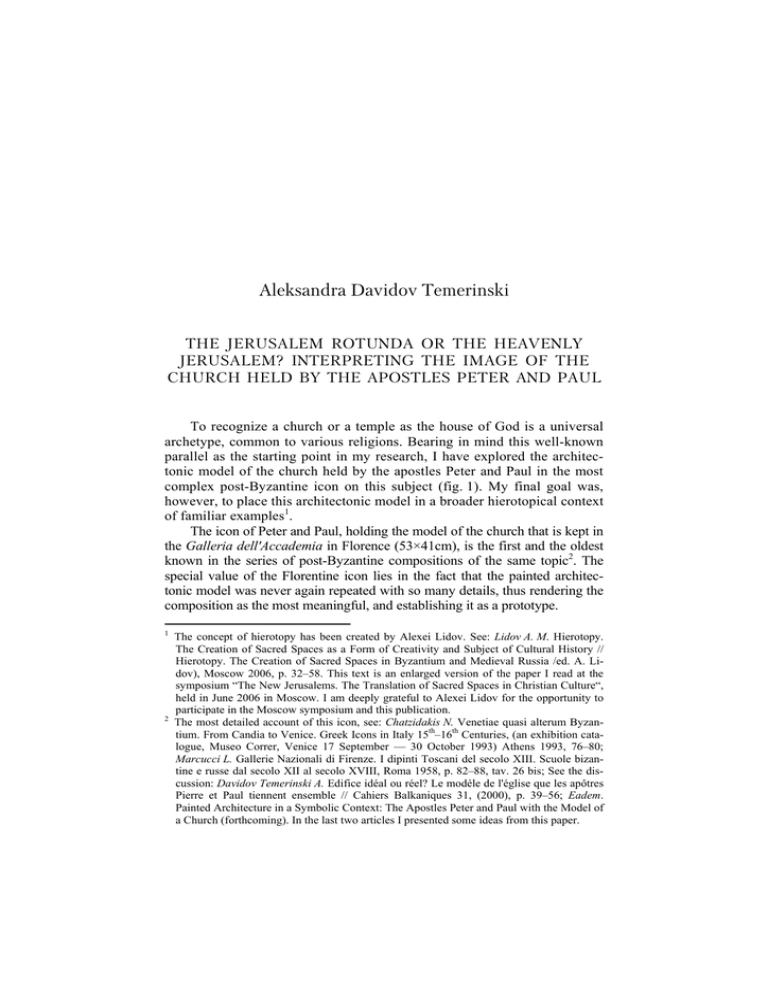
Aleksandra Davidov Temerinski THE JERUSALEM ROTUNDA OR THE HEAVENLY JERUSALEM? INTERPRETING THE IMAGE OF THE CHURCH HELD BY THE APOSTLES PETER AND PAUL To recognize a church or a temple as the house of God is a universal archetype, common to various religions. Bearing in mind this well-known parallel as the starting point in my research, I have explored the architectonic model of the church held by the apostles Peter and Paul in the most complex post-Byzantine icon on this subject (fig. 1). My final goal was, however, to place this architectonic model in a broader hierotopical context of familiar examples1. The icon of Peter and Paul, holding the model of the church that is kept in the Galleria dell'Accademia in Florence (53×41cm), is the first and the oldest known in the series of post-Byzantine compositions of the same topic2. The special value of the Florentine icon lies in the fact that the painted architectonic model was never again repeated with so many details, thus rendering the composition as the most meaningful, and establishing it as a prototype. 1 2 The concept of hierotopy has been created by Alexei Lidov. See: Lidov A. M. Hierotopy. The Creation of Sacred Spaces as a Form of Creativity and Subject of Cultural History // Hierotopy. The Creation of Sacred Spaces in Byzantium and Medieval Russia /ed. A. Lidov), Moscow 2006, p. 32–58. This text is an enlarged version of the paper I read at the symposium “The New Jerusalems. The Translation of Sacred Spaces in Christian Culture“, held in June 2006 in Moscow. I am deeply grateful to Alexei Lidov for the opportunity to participate in the Moscow symposium and this publication. The most detailed account of this icon, see: Chatzidakis N. Venetiae quasi alterum Byzantium. From Candia to Venice. Greek Icons in Italy 15th–16th Centuries, (an exhibition catalogue, Museo Correr, Venice 17 September — 30 October 1993) Athens 1993, 76–80; Marcucci L. Gallerie Nazionali di Firenze. I dipinti Toscani del secolo XIII. Scuole bizantine e russe dal secolo XII al secolo XVIII, Roma 1958, p. 82–88, tav. 26 bis; See the discussion: Davidov Temerinski A. Edifice idéal ou réel? Le modèle de l'église que les apôtres Pierre et Paul tiennent ensemble // Cahiers Balkaniques 31, (2000), p. 39–56; Eadem. Painted Architecture in a Symbolic Context: The Apostles Peter and Paul with the Model of a Church (forthcoming). In the last two articles I presented some ideas from this paper. 700 Aleksandra Davidov Temerinski Judging by its style, the icon belongs to the Italo-Cretan or ItaloByzantine stream of post-Byzantine painting. It should be dated to the late fifteenth or the beginning of the sixteenth century if the attribution to Nikolaos Ritzos (1460 — c. 1507) is accepted3. This attribution is mainly based on the comparative analysis of the icon of a Deesis framed with miniature scenes of the Dodekaorton and the saints, including Peter and Paul with a church, signed by Nikolaos Ritzos and kept in the Old Serbian Church in Sarajevo (figs. 2, 3)4. Nikolaos Ritzos could have used the iconographic model of the great «innovator», Angelos Akotantos, probably the most important Cretan painter in the first half of the fifteenth century and the author of several iconographic subjects that later would become typical of post-Byzantine art5. Maria Vassilaki proved that the Embrace of the two apostles was one of Angelos' favorite subjects6. Furthermore, it has almost the same meaning as the one of the apostles Peter and Paul holding the model of the church7. How and when our icon came to Florence, are questions for which there is no plausible answer, yet. It can only be traced in Florence from 19568. The two apostles are standing half-turned towards each other, holding the model of the church, while a half-figured Christ emerges from the segment of Heaven, blessing the apostles with outstretched arms. St. Peter holds the church with his right hand, and in his left, he holds the scroll of his Epistles and the keys illustrating Matt. 16: 19 „And I will give unto thee the keys of the kingdom of heaven“. Paul holds the church with his right hand and in his left he has a book of his Epistles and a sword, the attribute of his martyrdom, unusual in Orthodox iconography and typical of Roman Catholic ico3 Chatzidakis N. Venetiae quasi alterum Byzantium, p. 76, 78. Ibid. See also: Weitzmann K. et al. Icons. New York 1982, p. 311, fig. on p. 321; Rakić S. Ikone Bosne i Hercegovine (16–19. vijek). Beograd 1998, p. 185–186 (in Serbian with an English summary). 5 Vassilaki M. A Cretan Icon from the Aschmolean: The Embrace of Peter and Paul // JÖB 40 (1990), p. 411–415; Eadem. A Cretan Icon of Saint George // The Burlington Magazine CXXXI, (March 1989), p. 208–214. It is well known that Nikolaos' father, Andrea, possessed Angelos' iconographic drawings: Manoussakas M. Ή διαθήκη του Άγγελου Άκοτάντου (1436), αγνώστου κρητικού ζωγράφου // DChAE, 4th series, vol. 2 (1960– 1961), p. 139–151; Vassilaki-Mavrakaki M. Ο ζωγράφος Άγγελος Άκοτάντος το έργο και η διαθήκη του (1436) // Θησαυρίσµατα 18 (1981), p. 290–298. For a general discussion: Bouras L. Working Drawings of Painters in Greece after the Fall of Constantinople // From Byzantium to El Greco. Greek Frecoes and Icons, (an exhibition catalogue, Royal Academy of Arts, London, 27th March — 21st June 1987), Athens, 1987 p. 54–56. 6 Vassilaki M. A Cretan icon from the Aschmolean, p. 419–421. 7 Chrisanti Baltoyanni reasonably supposed that Angelos was the author of the post-Byzantine iconographic formula for both topics: Baltoyanni Ch. Icons, Demetrios Ekonomopoulos Collection, Athens, 1986, p. 88–89. 8 Marcucci L. Gallerie Nazionali di Firenze, p. 82. 4 The Jerusalem Rotunda or the Heavenly Jerusalem? 701 nography. Beneath the model of the church are verses inscribed in red9. Here is a translation: “Saviour, although you maintain the church through Peter and Paul, despite the sharp swords, leave it not without your support, as you deserve it with your holy blood”10. It seems that the relation between the sword in the hand of the apostle Paul and the “swords” from the epigram is purely formal. Otherwise, it is not possible to connect the attribute of the saint's martyrdom and the metaphor of “sharp swords” referring most probably to the specific historical and political obstacles the Church encountered at what is to us the unknown date of this epigram11. The background of the composition is gold and black. Formally, the two apostles turned towards each other and even embracing, are known from Early Christianity12, while the iconographical subject of a person holding the architectonic model is much older, reaching back to pre-classic presentations of architectonic maquettes as votive gifts13. The textual source and the fundamental meaning of the eastern Christian composition, depicting Peter and Paul with the model of the church, are partly derived from the liturgy, from the service held on their joint feast-day (June 29th). The apostles are mentioned there as “the true pillars and the walls of the Church”14. The second possible textual source is the verse from the Gospel of St. Matthew: “And I say also unto thee, that thou art Peter and upon this rock I will build my church; and the gates of hell shall not prevail against it” (16: 18). This iconographic formula is based on the dogma that recognizes the apostles as the leaders of the Church, meaning that they inherited the priesthood directly from Christ. Accordingly, the model of the church is interpreted as an ideogram of the universal Christian Church as an institution founded on the authority of the apostles. The octogonal edifice, covered with pale pink marble, has two ribbed domes of different size, or a dome and a lantern. There are eight windows on 9 For the Greek text, see: Chatzidakis N. Venetiae quasi alterum Byzantium, p. 76. Translation from Greek into Serbian was done by Dejan Dželebdžić, to whom I am grateful for his help. 11 In the opinion of D. Dželebdžić the epigram could have been written at some moment during the long period between the 13th and 15th century. 12 Huskinson J. M. Concordia Apostolorum: Christian Propaganda at Rome in the Fourth and Fifth Centuries // British Archaeological Reports International Series 148 (Oxford 1982); Kessler H. L. The Meeting of Peter and Paul in Rome // DOP 41 (1987), p. 265–275. See also: Pietri Ch. Concordia apostolorum et renovatio urbis. Culte des martyrs et propagande pontificale // Mélanges d’archéologie et d’histoire 73 (1961), p. 275–322. 13 Maquettes architecturales de l’Antiquité // Actes du colloque de Strasbourg, 3–5 décembre 1998, Paris 2001, p. 425–443; Pick B. Die tempeltragenden Gottheiten und die Darstellung der Neokorie auf den Münzen // Jahreshefte des Österreichisches Archäologishen Instituts VII, (1904), p. 1–41. I thank Čedomila Marinković for these references. 14 Minej za juni, Kragujevac, Vršac 1985, p. 410, 423. 10 702 Aleksandra Davidov Temerinski the drum, which is topped by a crenellation, typical of fortifications but here, it has no function. On the roof is a decorative metal fence of arcades. Neither decorative element on the church façade belongs to the repertoire of Byzantine sacral architecture, but to the Italian Renaissance. It is obvious that the model of this church is not typical of Byzantine architecture, which is mostly rectangular in form, even though the ground plan is a central one. Almost identical buildings are repeated in most of the later examples of this subject15. The well known fact is that in Byzantine and post-Byzantine art, the similarity between the real and the painted architecture in symbolic compositions is not clearly recognisable16. The latter, lacking sufficiently specified features, was used as an ideogram which could have been identified by an inscription or by the context of the composition. The composition of the apostles Peter and Paul holding the model of the church is related to the Council of Ferrara/Florence in 1438/39, most probably demonstrating an affirmative attitude to the Church union17. This assumption is supported by Manuel Philes' (1275–1345) epigram No184: “Είς τούς αγίους αποστόλους Πέτρον καί Παύλον ασπαζοµένους αλλήλους” where it is clearly stated that “the Embrace of Peter and Paul signifies the Union (ένωσιν) of Churches”, a subject very close in meaning to the one of the apostles Peter and Paul holding the model of the church, as was stated before18. Accordingly, the epigram in the lower register of the icon could be understood as a prayer to Christ for the unity of the split Christian church. In that sense “the sharp swords” mentioned in the epigram could have meant the disadvantages caused by the division of the Christian church into the 15 Several examples are commented by: Davidov Temerinski A. Edifice idéal ou réel? p. 47–49. The last discussion: Stavropoulou A. La représentation du Temple de Salomon dans les icônes crétoises: quelques aspects iconographiques // CahBalk 34 (2006), p. 145–157; See also: Stojaković A. Arhitektonski prostor u slikarstvu srednjovekovne Srbije, Novi Sad 1970, p. 177, 180, 183 (in Serbian with a French summary); For a different interpretation of the same type of architectonic model in the composition of the Entry into Jerusalem: as the Jerusalem Rotonda or the Temple of Solomon: Ильин М. Изображение Иерусалимского храма на иконе «Вход в Иерусалим» Благовещенского собора // ВВ 17 (1960), p. 105– 113; Стоякович А. Об изучении архитектурных форм на материале некоторых русских икон // ВВ 18 (1961), p. 116–123. 17 See the discussion: Vassilaki M. A Cretan Icon from the Aschmolean, p. 416–419; See also: Davidov Temerinski A. Concordia Apostolorum: Zagrljaj apostola Petra i Pavla. Povodom freske iz Mušnikova kod Prizrena // Zbornik Matice Srpske za likovne umetnosti 32/33 (2003), p. 83–105 (in Serbian with an English summary). 18 Vassilaki M. A Cretan Icon from the Aschmolean Museum, p. 419. Nevertheless, by union, Manuel Philes obviously did not mean the Christian Church united under the leadership of the Pope. See the recent analysis of the metropolite Bessarion’s attitude during the Florentine Council: Ronchey S. Orthodoxy on the Sale. The Last Byzantine and the Lost Crusade // Proceedings of the 21st International Congress of Byzantine Studies, London 21–26 August, 2006, vol. I, Plenary Papers, London (Ashgate) 2006, p. 317–318. 16 The Jerusalem Rotunda or the Heavenly Jerusalem? 703 Roman Catholic and Eastern Orthodox one. In the context of these circumstances, the church depicted on the Florentine icon was interpreted as an allusion to the cathedral in Florence, Santa Maria del Fiore (fig. 4)19, where the last union of the Eastern and the Western Church was solemnly proclaimed on July 6, 143920. In fact, it is possible to distinguish certain similarities in the altar part of the Florentine building and the church on the icon with Peter and Paul. They both have an octogonal base, façades with marble slabs and either two domes one above the other, or a dome with a lantern. Yet, although the crenellation and the metal fence do not exist on the Florentine Cathedral, the fact that this very building was a real «protagonist» in the important historical event in 1439 makes this assumption undoubtedly attractive. Nevertheless, the purely Orthodox interior of the depicted church with an iconostasis and open Royal doors, which could not exist in any Roman Catholic church, including the Florentine one, argues against this hypothesis (fig. 5). Accordingly, the Italian elements on the exterior did not originate from any particular church, but rather from the repertoire of Italo-Byzantine iconography, like the sword in the hand of St. Paul. Another interpretation of the architectonic model on the Florentine icon is possible. It can be seen as a reference to the Church of the Holy Sepulchre in Jerusalem (fig. 6), more precisely, to the Rotonda, the name given to the altar part because of its circular ground plan (fig. 7)21. A comparison between the plan of the Rotonda, and of the architectonic model on the icon, will show that the first one is circular, whereas the other is octogonal. However, one should bear in mind that among the architectonic “copies” of the Rotonda, there were more polygonal buildings than those with a circular plan, which Richard Krautheimer noted in his fundamental study of the iconography of medieval architecture22. “...As early as in the fourth century, 19 Chatzidakis N. Venetiae quasi alterum Byzantium, 80. Gill J. The Council of Florence, Cambridge 1959, p. 293. 21 A similar model of the church on an icon of the same topic was identified by Tzeni Albani as a reference to the Rotonda of the Holy Sepulchre church. Albani Tz. Ο περίπλους των εικόνων: Κέρκυρα, 14ος –18 ος αιώνας, (an exhibition catalogue), Korfou 1994, p. 105–107. See also: Davidov Temerinski A. Edifice idéal ou réel? p. 47; Stojaković A, Pokušaj određivanja realnih vrednosti jednog slikanog arhitektonskog tipa // Zbornik Arhitektonskog fakulteta VI (1960/61), p. 3–12 (in Serbian with a French Summary); Kühnel B. From the Earthly to the Heavenly Jerusalem. Representations of the Holy City in Christian Art of the First Millenium, Rom — Frieburg — Wien 1987, p. 81–93; Иерусалим в русской культуре / Ред. А. Баталов, А. Лидов. Москва, 1994; Jerusalem in Russian Culture / Eds. A. Batalov and A. Lidov, New York — Athens 2005 (an English edition). 22 Krautheimer R. Introduction to an 'Iconography of Medieval Architecture' // JWCI V (1942), 1–33, reprinted in: Idem. Early Christian, Medieval and Renaissance Art. New York 1969, p. 115–150, especially p. 118–119. 20 704 Aleksandra Davidov Temerinski Gregory of Nyssa described the plan of an octogonal church as forming ‘a circle with eight angles’”23. The symbolic value of the number eight is connected to the Resurrection, which, as least theoretically, could have also been the reason for changing the plan of the church from a circular to an octogonal one24. The painted Church on the Florentine icon refers to the Rotonda as a metaphor for the universal Church built over the “historical” spot of Christ’s empty tomb, which, most convincingly, embodies the final aim of every believer: eternal life given by the resurrected Messiah to mankind. The real connection of the Holy Sepulchre with the place of Christ’s resurrection has given that church a unique position in the Christian world from the times when it was built. Eusebius of Caesarea already hinted at the Church of the Holy Sepulchre as the focal point of the ideological background of Emperor Constantine's building program25. Although it was built ex-muro of the fourth century city of Jerusalem, in the IX Laudae to the emperor Constantine, Eusebius symbolically located the Church of the Holy Sepulchre in the middle of the town, whereby it became the omfalos, “the navel of the world”, implying that it was also the cosmic centre26. Constantine’s ideological and building program implied the continuity with the Judean tradition that had existed before, namely, with Jerusalem’s most important edifice from earlier times: Solomon’s Temple, demolished by the Romans in 70 B.C.27 Soon after the Church of the Anastasis was erected, some of the most venerated symbols of Jewish history that are traditionally connected with the Temple were transferred there28.This process culminates in the identification of Golgotha with the place of Adam's creation and of his grave, thus embracing the whole sacred history from the beginning of the Old Testament (Book of Genesis) to the New Testament (Gospels) and achieving the most complete model of universal continuity.29 This identification enters the standard iconography of the Crucifixion with Adam's skull beneath the cross. The painted church interior is rich in details and perfectly visible, which is enabled by the presentation of the building with almost no walls from the 23 Ibid. In reality, it was easier for builders to construct an octogonal church than a circular one. 25 Kühnel B. From the Earthly to the the Heavenly Jerusalem, p. 83. 26 Ibid., p. 88, 92–93; Ousterhout R. The Temple, the Sepulchre and the Martyrion of the Savior // Gesta XXIX/1 (1990), p. 46–47. 27 Herselle Krinsky C. Representations of the Temple of Jerusalem before 1500 // JWCI XXIII (1970), p. 2. 28 Kühnel B. From the Earthly to the the Heavenly Jerusalem 84; Hersellel Krinsky C. Representations of the Temple of Jerusalem, p. 5; Ousterhout R. The Temple, the Sepulchre, p. 46–47. 29 Kühnel, B. From the Earthly to the the Heavenly Jerusalem, p. 88. 24 The Jerusalem Rotunda or the Heavenly Jerusalem? 705 west, south and north sides, thus, in a way, resembling a ciborium (fig. 8)30.Through the open Royal Doors, one can even see the altar space, with the Gospel, the chalice, the spoon and tongs lying on the altar table31,referring to the rite of the Eucharist. The black vault beneath the dome, sprinkled with stars, is alluding to the firmament. On the low iconostasis are, as always, icons of Christ to the right of the Royal Doors, and to the left, the Mother of God Hodegetria with the Christ Child. In the same row are icons of six-winged cherubim holding lances in both hands, which is, to the best of my knowledge, a unique motif in the iconostases that are preserved. As the only motif besides those on the two main icons, the cherubim play a significant role here, alluding to Paradise and underlining the eschatological meaning of the greatest holy mystery, the Eucharist. The cherubim are the guardians of Paradise, the “historical” prefiguration of the Heavenly Jerusalem, according to the Book of Genesis, where it is said that after He banished Adam and Eve, God placed cherubim at the entrance to the garden of Eden (Gen. 3, 4). The second role of the cherubim arises from the first, according to which they act as guardians of the most sacred places, such as the lid of the Ark of the Covenant, the Holy of Holies of the Tabernacle and the Temple of Solomon, and, finally, the altar space of the Christian Church32. It was recently hypothetically deduced by Irina Shalina that the frequent appearance of icons depicting archangels on the side doors of later Russian iconostases derived from possible earlier presentations of cherubim in the same place, although no example has been preserved33. Despite the fact of not being real icons but presented in the virtual interior of the painted church, the cherubim on the side doors of the iconostasis on the Florentine icon, could have been regarded as an argument in favour of Shalina’s hypothesis. The iconostasis is decorated only with a shell motif on the epistyle. Although the shell was a relatively frequent motif in fifteenth century woodcarving34, it is probable that it was no coincidence, since the choice of the motifs on the painted iconostasis was highly selective. The shell was often 30 Bouras L. Ciborium // ODB, vol. I, p. 462. I warmly thank Blagota Pešić for the drawing of the church interior and the drawings of the much damaged fresco in St. Andrew's church in Peristera (fig. 10) and the icon by Ioannis Apakas (fig. 18). 31 According to the description by Nano Chatzidakis since I had no opportunity to see the icon. Chatzidakis N. Venetiae quasi alterum Byzantium, p. 78. 32 Arc of the Covenant (Exodus 25: 18–22; 37: 7–9); Tabernacle (Exodus 36: 8); Temple of Solomon (1 Kings 6: 23–35). The description of the Temple of Solomon is repeated in 2 Chronicles 3. 33 Шалина И. А. Боковые врата иконостаса: символический замысел и иконография // The Iconostasis. Origins, Evolution, Symbolism / Ed. A. Lidov. Moscow, 2000, p. 568 (in Russian, with an English abstract). 34 Chatzdakis M. Icons of Patmos. Athens, 1985, p. 35. 706 Aleksandra Davidov Temerinski used in the Roman and Jewish tradition, as demonstrated by the fresco in the synagogue in Dura Europos above the Torah shrine (244–245) (fig. 9), and later, on the Palestinian ampulae from the sixth century35. The relationship with the divinity, the sublime and glory were the contents ascribed to this motif36. By its shape, indeed, it refers to the firmament. The sacred vessels are associated with the rite of the Eucharist, which, as Milan Radujko concisely assessed: “designated at the Last Supper, as the central mystery in the economy of salvation, as the sacrament which, besides the redeeming act of the Crucifixion and the Resurrection of Christ, actualizes the eschatological reality of the Kingdom of Heaven”37. And further: "Repeated daily in liturgical texts, and in all liturgical literature, numerous verses indicate that the notion of the Eucharist as the mystery offering access to the Kingdom of Heaven was well known”38. The iconostasis and the altar table in the church interior on the Florentine icon may be understood as a message consisting of five elements. The motifs are: the altar table located in the middle with the liturgical instruments (inferring the passion/resurrection/redemption), between the icons of Christ (the Incarnation) and the Virgin with the Christ Child (the Incarnation), flanked by the icons of the cherubim (the allusion to Eternal Life). This interpretation of the church interior concisely expresses fundamental Christian dogma: God the Father sent his Son to be incarnated through the body of the Blessed Virgin. Then He sacrificed him to redeem Man from Original Sin and establish a New Covenant with Mankind, offering it the guarantee of returning to dwell in Paradise/Heavenly Jerusalem. Here, Heavenly Jerusalem is understood as the Communion of the Faithful, not the apocalyptic vision of the city John the Evangelist describes in Revelation. One could say the Florentine icon almost has the character of a manifest. Depending on its date, or the date of its lost model, this iconographic formula may have been created on the occasion of the Council in Ferrara and Florence, where it is kept today39. The manifold importance of the unionist Council may have been the reason that induced the iconographer to create a 35 Grabar A. Ampoules de Terre Sainte. Paris, 1958 (Monza 13 and 14, Bobio 3 and 15); Ousterhout R. The Temple, the Sepulchre, p. 47–48. 36 Ibid., p. 49. 37 Radujko M. Eklisijalno-eshatološki simbolizam u evharistijskoj tematici vizantijskog umetničkog kruga. Nebeski Jerusalim u Pričešću apostola iz Bogorodice Odigitrije i vrata Nebeskog grada u Pričešću iz Sv. Dimitrija u Pećkoj patrijaršiji // Zograf 23 (1993/1994), p. 35 (in Serbian with a French summary). 38 Ibid. 39 The author of the prototype of the post-Byzantine subject was probably Angelos in the first half of the fifteenth century. Nikolaos Ritzos could have painted its replica, using a working drawing or an icon by Angelos (see n. 5 and 6). Unfortunately, according to what we know at present, it is impossible to prove this hypothesis. The Jerusalem Rotunda or the Heavenly Jerusalem? 707 visual message about the meaning of faith and the institution that represented it40. Theoretically speaking, the image of the Church as an institution could have been changed by the decisions of the Florentine Council. Also, one should note that during the Byzantine period, the iconographic formula with Peter and Paul holding the model of the Church was extremely rare. The only surviving Byzantine example of a composition on this subject is the ninth century fresco in the Church of Saint Andrew in Peristera, near Thessaloniki (fig. 10)41. Its appearance was connected with the first schism at the Council in 867 A.D., and can be interpreted as the reflection of a wider ideological program that was implemented at that time by Photius, patriarch of Constantinople (from 858 to 867 and from 875 to 886)42. If we take into account the fact that representations of the first two among the apostles have always demonstrated political or, at least, ideological messages43, the significance of the link between these subjects and the last attempt of the Church union in 1438/39 became even more emphasized. The next preserved example of the apostles Peter and Paul with a church is the icon in Florence connected with the Florentine Council, beginning the series of icons or frescoes from the late fifteenth to the eighteenth century. All of them represent the similar architectonic model: Nikolaos Ritzos’ icon from the Serbian Orthodox Church in Sarajevo44, the fresco from the Peter and Paul church in Tirnovo45, (both from the late fifteenth century), two unpublished icons from 40 Chrisanti Baltoyanni suggested that this iconographic formula was created for the Florentine Council as a gift of the Byzantine delegation to their hosts in Italy (Icons, Demetrois Economopoulos Collection p. 89), but there is no argument to support it. About the spiritual climate among Byzantine intellectuals, their reception of the purpose and the results of the Union: Ševčenko I. Intellectual repercusions of the Council of Florence // Church History XXIV, No 4, Dec. 1955, p. 3–34. See also: Idem. The Decline of Byzantium Seen through the Eyes of its Intellectuals // DOP 15 (1961), p. 169–186; For the history of the Council there is an exhaustive bibliography. See two major works: Gill J. The Council of Florence; and: Les «Mémoires» du grand Ecclésiarque de l'Eglise de Constantinople Sylvestre Syropoulos sur le concile de Florence (1438–1439) / Ed. V. Laurent. Paris, 1971. 41 Mavropoulou-Tsioumi Ch. The Painting of the Ninth Century in the Church of SaintAndrew «Peristera » // Zograf 26 (1997), p. 7–16. For the related formula on the Constantinopolitan lead seals, also from the Byzantine period (11th–14th century) with the emperor Justinian and the Holy Virgin holding the model of the St. Sophia Cathedral, see: Бутырский М. Н. Печати Великой церкви. Образ сакрального пространства в иконографии византийских молидовулов // Hierotopy. The Creation of Sacred Spaces, p. 465–479 (In Russian with an English summary). 42 Mavropoulou-Tsioumi Ch. The Painting of the Ninth Century, p. 8–9. 43 See n. 12 and 18. 44 Weitzmann K. et al. Icons, p. 311. 45 Garidis M. La peinture murale dans le monde orthodoxe après la shute de Byzance (1459– 1600) et dans les pays sous la domination étrangère, Athènes, 1989, p. 106–107; see also: Ždrakov Z. Stenopisite na crkvata «Sveti Petar i Pavel» v Trnovo ot XV vek i kritskata živopis v svetlinata na novite proučavanja // Problemi na izkustvoto, 4 (1991), p. 50–56. 708 Aleksandra Davidov Temerinski Byzantine and Christian Museum in Athens, the icon from the Municipal Cemetary in Korfou (fig. 11), all three dated to the end of the sixteenth and the begining of the seventeenth century, just to mention several examples46. The ecclesiastical, soteriological and eschatological meaning of the church on the icon in Florence is dogmatically complemented by the figures of the apostles and Christ. Here, the Heavenly Jerusalem is indicated as a sacred space promised to all regular participants in the life of the Church. The analysis of the motifs used for the architectural model on the Florentine icon reveals an extremely soft line of distinction between the images referring to the Jerusalem Rotonda and the allusion to the Heavenly Jerusalem. Several compositions can serve as additional arguments to support my hypothesis. The first example is in the southern church dedicated to the Mother of God Hodegetria (ca. 1335), part of the triple-church catholikon of the Peć Patriarchy monastery in Metohija (fig. 12)47. In the second zone of the apse, in the centre of the Communion of the Apostles, instead of a ciborium, there is the motif of a church with the cherubim painted in grisaille on its façade. This unique iconographic detail has been interpreted in different ways (as an arthophorion48, as an allusion to the Tabernacle49, the Church of Sion50, or the Church of the Holy Sepulchre51). At last it was proved convincingly that the mysterious motif represents a metaphor of the Church — the Heavenly Jerusalem52. Although the fresco composition is formally different from the one on the icon — their meanings are very close. In both cases, the message is that with its central rite — the Eucharist — the Church has the power to offer the Kingdom of Heaven to the faithful. The basic elements in both compositions are: Christ and the apostles (on the icon only two leaders are depicted), and the rite of Holy Communion. The fresco painting includes the real space of the church in the meaning of the composition, whereas on the icon, the church had to be painted so that its meaning would be clearly expressed in visual terms. Where the fresco is concerned, Holy Communion is presented as a customary, 46 Vokotopoulos P. L. Εικόνες της Κέρκυρας, Athens, 1990, p. 95–96, fig. 176. More examples have been the subjects of my research in: Davidov Temerinski A. Painted Architecture in a Symbolic Context (forthcoming). 47 Ćirković S., Korać V., Đurić V. J. Pećka patrijaršija. Beograd, 1990. 48 Radojčić S. Staro srpsko slikarstvo. Beograd, 1966, p. 124. 49 Todić B. Tradition et innovations dans le programme et l'iconographie des fresques de Dečani // Dečani et l'art byzantin au milieu du XIVe siècle, Colloque scientifique international de l'Académie serbe des sciences et des art, Belgrade, 1989, p. 261 (in Serbian with a French summary). 50 Idem. Ikonografski program fresaka iz XIV veka u Bogorodičinoj crkvi i priprati u Peći // L’archevêque Danilo II et son époque, Colloque scientifique international de l'Académie serbe des sciences et des art. Belgrade, 1991, p. 371–372 (in Serbian with a French summary). 51 Stojaković A. Pokušaj određivanja realnih vrednosti, p. 3–12. 52 Radujko M. Eklisijalno-eshatološki simbolizam, p. 32–39. The Jerusalem Rotunda or the Heavenly Jerusalem? 709 symbolical composition following the standard iconographic program of the altar space, while in the icon, the altar and instruments required for Holy Communion clearly refer to the same mystery. The second example is the fresco in the Church of the Virgin Peribleptos in Ohrid, (1295/96) (fig. 13)53. It shows the apostle Peter holding the model of the church on his shoulders, which is a literal illustration of Christ's words (Matt. 16: 18). The apostle is trampling Satan, who is bound, while an angel, presented in the same posture as in the Last Judgement iconography, helps him by prodding at Satan with a lance. The half-length figure of Christ is blessing the apostle. It is obvious that, apart from the conquered personification of Evil, the composition from the Virgin Peribleptos church in Ohrid, formally, is very similar to the one on the Florentine icon. Still, St. Peter in the church of the Virgin Peribletos is the only presented apostle, following the text of the Gospel. One should note that these two formulas do not belong to the same iconographic tradition. A composition with the apostle Peter was created for the very first time in the Ohrid church, by the painters from Thessaloniki, Michael Astrapa and Eutihios54. Almost the same composition, but without the defeated Satan, appeared later in the Saviour church in the Žiča monastery (ca. 1310) (fig. 14)55, in the Church of the Annunciation in the Gračanica monastery (1320) (fig. 15)56, and in the Pantocrator church in the Dečani monastery (ca. 1338–1348) (fig. 16)57. The cherubim did not appear in any of the painted churches on these frescoes (Žiča, Gračanica and Dečani) neither did the altar space, nor the instruments of Holy Communion. Obviously, the references to Paradise and to the Eucharist were omitted, all three churches being depicted as closed. The third example is a relief on the southern façade of the church dedicated to the Presentation of the Virgin in the Kalenić monastery, built in the 53 Ibidem, p. 35. See the discussion: Todić B. Freske u Bogorodici Perivlepti i poreklo Ohridske arhiepiskopije // ZRVI 39 (2001/2002), p. 147–163 (in Serbian with an English summary). 54 The fresco ensemble in Ohrid is the first signed by these two painters. They were to continue their work in Serbia during the reign of King Milutin (1282–1321), who, during the first two decades of the fourteenth century, built and decorated more churches than any of his contemporaries. Thanks to these circumstances, the work of these painters can be followed almost «step by step» over a period of more than twenty five years, which is a unique case in Byzantine painting. For the last discussion, see: Marković M. Umetnička delatnost Mihaila i Evtihija. Sadašnja znanja, sporna pitanja i pravci budućih istraživanja // Zbornik Narodnog muzeja XVII/2‚ Beograd, 2004, p. 95–113 (in Serbian with an English Summary); Idem. The Painter Eutychios — Father of Michael Astrapas and Protomaster of the Frescoes in the Church of the Virgin Peribleptos in Ohrid? http://www.byzantinecongress.org.uk/postlist.html. 55 Todić B. Serbian Medieval Painting. The Age of the King Milutin. Belgrade, 1999, p. 162–163. 56 Idem. Gračanica. Slikarstvo, Beograd — Priština, 1988, p. 166, fig. 56 (in Serbian, with an English summary). 57 Marković M. Hristova čuda i pouke // Mural painting of monastery of Dečani (ed. V. J. Đurić), Beograd, 1995, 142, fig. 6 (in Serbian, with an English summary). 710 Aleksandra Davidov Temerinski second decade of the fifteenth century58. Тhe relief shows the icon of the standing Virgin Hodegetria with a Child framed in simple floral ornaments and flanked by two cherubim (fig. 17). The façade of the real church is marked by the sign of the Heavenly Jerusalem represented by the icon of the church patron, the Virgin with the Child, the symbol of the incarnation of Logos and the means of mankind's Redemption between two cherubim. Accordingly, the floral ornamentation framing the icon of the Virgin could have been interpreted as an allusion to the Garden of Paradise. While describing the Ark of the Covenant to Moses, Jahweh stated that He will speak to Moses from the lid of the Ark between the two cherubim (Ex. 25: 22). From that moment on, the image of the cherubim flanking the saintly figure became an eschatological association with God's presence, which is widely known from medieval Christian iconography. The relief on the Kalenić southern façade is also a reminder of the identification of the Mother of God with the Church, which was a popular theological and liturgical comparison and often used in medieval visual arts. The Kalenić relief is placed purposely above the nowadays closed, biphora-like entrance on the south wall of the narthex and cannot be missed by any of the visitors, since the original entrance to the monastery was located on the south-eastern side and led to the western portal of the church along its southern wall59. Thus, the location of the relief clearly demonstrates the prominent significance it had for the program-maker of the exterior decoration of the Kalenić church, which has quite recently been interpreted as an allusion to the Heavenly Jerusalem60. The hierotopical approach enables us to connect four different visual presentations of the Church/Heavenly Jerusalem in one group: the icon with a painted church, two frescoes inside the real church and the icon in relief on the church façade. Two common elements for these examples are the church (painted or real) and the cherubim. The image-paradigm of the Heavenly Jerusalem, the term proposed by Alexei Lidov61, exists as a two-dimensional image and at the same time as a spatial image. The architecture, the painted or relief decoration, as well as the ritual, constituted an ensemble of the elements that represented to medieval believers the only natural way of the perception of sacred space62. 58 Simić-Lazar D. Kalenić et la dernière période de la peinture byzantine, Skopje 1995 (for the history and the painting); Eadem. Kalenić, Slikarstvo, istorija. Kragujevac, 2000 (Serbian edition with an English summary); Stevović I. Kalenić, Bogorodičina crkva u arhitekturi poznovizantijskog sveta. Beograd, 2006 (for the architecture; in Serbian). 59 Kalenić, Duhovno blago u novom sjaju. Obnova manastira 1991–1997, Rekovac — Beograd, 1998, 48–49 (popular edition). 60 Stevović I. Kalenić, p. 169–180; See also in this volume: Idem. Late Byzantine Church Decoration as an Iconic Vision of the Heavenly Jerusalem: the Case of Kalenić. 61 Lidov A. Hierotopy. The Creation of Sacred Spaces, p. 42–43. 62 Ibid. The Jerusalem Rotunda or the Heavenly Jerusalem? 711 Finally, it could be said that the metaphor of the Church — Heavenly Jerusalem is an image-paradigm that can have the most varied appearences due to its general, all-embracing significance63. Considering that the primary meaning of the painted architecture on the Florentine icon is the Church as an institution, this research has testified, once again, to the multiple meaning of the iconographic motifs, thus representing one of the main features of the Byzantine / Eastern Christian medieval, visual system. In the last part of this essay, I shall pay attention to the striking similarity between the church on the Florentine icon and the Temple of Solomon depicted on an Italo-Cretan icon from the sixteenth century by Ioannis Apakas, housed in the Museum of the Istituto Ellenico in Venice (fig. 18)64. Apakas' icon represents the city of Jerusalem enclosed by an encente with four doors and numerous tower-like buildings ending in lanternas. The ciborium-like Gothic building in the centre of the composition is an octogonal open structure with the dome and lanterne identified by an inscription as Ο ΝΑΟΣ ΤΟΥ ΣΟΛΟΜΩΝΤΟΣ, the Temple of Solomon. In the interior of the building, the twelve-year old Christ is sitting in the center on an elevated throne, while the Jewish doctors are standing in the temple or outside it and listening to Jesus' words, illustrating Lk. 2: 46–50. The text on an open scroll at the bottom of the composition is quoting the verse by the evangelist Luke (4: 8) about the temptation of Christ by the Devil. In the next verse (4: 9), not written on the icon, the Temple is mentioned: “And he brought him to Jerusalem, and set him on a pinnacle of the temple, and said unto him, if thou be the Son of God, cast thyself down from hence”. It is obvious that the inscription on the scroll and the scene of the twelve-year old Christ preaching in the Temple are not in any connection except for the Temple, which, judging by the title, is, indeed, the main subject of the composition65. In the medieval Latin West, the Temple of Solomon, constructed through divine inspiration, was conceived as the ideal model of the church and a prefiguration of the image of the Heavenly Jerusalem (Rev. 22)66. It is very probable that this idea lay behind the concept of Apakas’ unique icon. The Temple of Solomon on Apakas’ icon — modeled as an open, octogonal church with a dome, lanterne and the decorative crenellation — demonstrates the closest parallel to the church on the Florentine icon. Similar churches, represented on the two Italo-Byzantine icons, could have been con63 Lidov A. Heavenly Jerusalem: The Byzantine Approach // The Real and Ideal Jerusalem in Jewish, Christian and Islamic Art / Ed. B. Kühnel. Jerusalem, 1998, p. 341–353. 64 Stavropoulou A. La représentation du Temple, p. 145–157, fig. 10. 65 Ibid., p. 154. 66 Kenaan-Kedar N. Symbolic Meaning in Crusader Architecture. The Twelfth-Century Dome of the Holy Sepulcher Church in Jerusalem // CA 34 (1986), p. 113. 712 Aleksandra Davidov Temerinski ceived as reminders of the history of the Temple Mount and the Holy Sepulchre, the most holy Judeo-Christian sites in Jerusalem. For, the place where the Temple of Solomon once stood on the Temple Mount, was thought to be the same where the Muslim Dome of the Rock was erected (completed in 691) as a memoria of Mohammed’s journey to Heaven67. Further, the model for the Dome of the Rock was the dome of the Holy Sepulchre68. Pilgrimage literature testifies to the conviction of Westerners from the eleventh to the fifteenth century that the Dome of the Rock and the Al-Aqsa mosque were actually Solomon’s buildings — his Temple and his Palace69. Immediately after the crusader's conquest of Jerusalem in 1099, the Dome of Rock was converted into the church of the Templum Domini70. During the crusader period of Jerusalem (1099–1187) a reverse process went on of transferring the holy traditions from the Holy Sepulchre to the Templum Domini71. Among many other and more significant consequences of these historical and ideological circumstances the phenomenon of blending the forms and their meanings emerges, where the presentations of the architecture of the Temple of Solomon and the Rotonda of the Holy Sepulchre are concerned. It is testified here by the two Italo-Byzantine icons, the Florentine and the Venetian. Also, the church in the composition of the Entry into Jerusalem has been interpreted as the reference to the Holy Sepulchre or the Temple of Solomon72. This phenomenon becomes even more provocative when we take into account the fact that the visual presentations of the Temple of Jerusalem were inspired by the Muslims' building, adopted in the minds of medieval pilgrims as the Jewish Temple. Finally, the Jerusalem Temple as an Old Testament prototype and the Jerusalem Rotonda as a New Testament prototype could have been used equally and supremely as images of the metaphor of the Church — Heavenly Jerusalem, namely before any other Christian building. Taking into consideration this layer of their meaning, one could conclude that the similarity of their presentations originated as much from the historical and ideological facts I mentioned earlier as from the complex symbolism of the Eastern Christian subject of the Church — Heavenly Jerusalem. 67 Herselle Krinsky C. Representations of the Temple of Jerusalem, p. 3–4. Grabar O. The Formation of Islamic Art, New Haven 1973, 64–65; Ousterhout R. The Temple, the Sepulchre, p. 47. 69 Herselle Krinsky C. Representations of the Temple of Jerusalem, p. 6. 70 Kenaan-Kedar N. Symbolic Meaning, p. 113–114 71 Ibid. 72 See n. 16. 68 The Jerusalem Rotunda or the Heavenly Jerusalem? 713 Александра Давидов Темерински Institute for the Protection of Cultural Monuments of Serbia, Belgrade ИЕРУСАЛИМСКАЯ РОТОНДА ИЛИ НЕБЕСНЫЙ ИЕРУСАЛИМ? ИНТЕРПРЕТИРУЯ ОБРАЗ ЦЕРКВИ В РУКАХ АПОСТОЛОВ ПЕТРА И ПАВЛА В данной публикации исследуется смысл образа церкви, которую держат апостолы Петр и Павел на сложной по композиции поствизантийской иконе, которая хранится в галерее Академии во Флоренции. Однако конечная цель данной статьи — поставить архитектоническую модель на иконе в более широкий иеротопический контекст известных образцов. На иконе изображены Петр и Павел, которые держат модель церкви, а рядом — благословляющая полуфигура Христа в сегменте небес. Между фигурами апостолов, в нижней части иконы, написана стихотворная эпиграмма. Это старейший из известных пример в целой серии италовизантийских композиций того же сюжета. Нарисованная архитектоническая модель ни в одной из них не повторялась с таким обилием деталей, так что значение данной иконы особенно велико, поскольку именно она является прототипом. Икона датируется концом XV — началом XVI вв., если принять атрибуцию ее Николаосу Рицосу (1460 — ок. 1507). На иконе изображено восьмиугольное здание, облицованное бледно-розовым мрамором, с двумя ребристыми куполами разного размера и фонарем. Барабан увенчан зубцами, а на крыше находится декоративная металлическая ограда с аркадой. Эти две черты происходят от ренессансной архитектуры и ясно показывают влияние итальянского искусства, что типично для итало-византийской живописи. Архитектоническая модель, представленная на флорентийской иконе в руках апостолов Петра и Павла, является идеограммой вселенской христианской Церкви как института, основанного на авторитете апостолов. Данная работа раскрывает второй смысловой уровень, отсылая к Ротонде Гроба Господня как метафоре вселенской Церкви, построенной на «историческом» месте могилы Христа, который, как считалось, воплотил конечную цель каждого верующего: вечную жизнь, дарованную воскресшим мессией человечеству. Реальная связь Ротонды с местом воскресения Христа определяла уникальное положение этой церкви в христианском мире с самого момента ее постройки. Иерусалимская Ротонда часто изображалась в виде восьмиугольника, как это видно и на флорентийской иконе. В интерьере церкви, сквозь открытые Царские Врата иконостаса, можно увидеть алтарное пространство с Евангелием, потиром, лжицей 714 Aleksandra Davidov Temerinski и копием на алтарном престоле, что символизирует приуготовление к Евхаристии. На низком иконостасе видны иконы Христа и Богоматери Одигитрии с Младенцем Христом. В том же ряду икон шестикрылые херувимы обеими руками держат копья — насколько мне известно, этот мотив уникален для сохранившихся иконостасов. Херувим играет важную роль в символике рая — Небесного Иерусалима и указывает на эсхатологические коннотации величайшего священного таинства — Евхаристии. Таким образом, проявляется и третий смысловой уровень архитектонической модели как метафоры Церкви — Небесного Иерусалима. Она показана здесь как образ сакрального пространства, обещанного всем, кто ведет регулярную жизнь во Христе. Несколько композиций могут служить дополнительными аргументами в поддержку моей гипотезы. Первая находится в церкви Богоматери Одигитрии (ок. 1335) в Пече Патриаршьего монастыря в Метохии. Во второй зоне апсиды, справа от центра, есть композиция Причастия апостолов, в которой вместо обычного кивория дан уникальный мотив церкви с херувимом, написанным гризайлем на ее фасаде. Второй пример — фреска церкви Богоматери Перивлепты в Охриде (1295/96) с апостолом Петром, который держит на плечах модель храма и попирает сатану, в то время как ангел пронзает того копьем (Матф 16: 18). Как и в иконостасе, изображенном на флорентийской иконе и в церкви Богоматери Одигитрии, на фасаде нарисованной церкви виден херувим. Третий пример — рельеф на южном фасаде церкви в монастыре Каленича, посвященной Введению Богородицы во храм и построенной в 1420-х гг. Рельеф показывает икону стоящей Богородицы с Младенцем, окаймленную растительным орнаментом и фланкированную двумя херувимами. Здесь, на реальном церковном фасаде отчетливо виден знак Небесного Иерусалима, представленного иконой церковного патрона и херувима. Иеротопический подход позволяет нам установить связь между четырьмя изображениями Церкви как Небесного Иерусалима и объединить их в одну группу: икона с нарисованной церковью, две фрески внутри реального храма и икона на рельефе церковного фасада. Два общих элемента, характерных для всех этих примеров, это церковь (нарисованная или реальная) и херувим. Данное исследование доказывает, что эта церковь, символизирующая Небесный Иерусалим, — это образпарадигма, способная принимать разное обличие, но сохраняющая единый, всеобъемлющий смысл. В заключительной части статьи внимание уделено поразительному сходству между церковью на флорентийской иконе, обозначающей иерусалимскую Ротонду, и церковью на иконе, представляющей Храм Соломона, исполненной Иоаннисом Апакасом, которая с XVI в. нахо- The Jerusalem Rotunda or the Heavenly Jerusalem? 715 дится в музее Эллинского института в Венеции. Похожее на киворий готическое здание в центре уникальной венецианской иконы представляет собой восьмиугольную открытую структуру с зубчатым барабаном и куполом с фонариком. Надпись позволяет идентифицировать нарисованное строение как Храм Соломона. Внешний облик церкви являет собой ближайшую параллель храму на флорентийской иконе. Это подтверждает крайне интересный феномен слияния форм и смыслов при изображении архитектуры двух основных иудео-христианских сакральных зданий: Ротонды Гроба Господня и Храма Соломона. Сходные или идентичные средневековые образы иерусалимского Храма как ветхозаветного прототипа и иерусалимской Ротонды как новозаветного прототипа в равной мере превосходно иллюстрирует метафору Церкви как Небесного Иерусалима. 716 Aleksandra Davidov Temerinski 1. Apostles Peter and Paul with a model of the Church, Galleria dell’Accademia, Florence, Nikolaos Ritzos (?) (after N. Chatzidakis) The Jerusalem Rotunda or the Heavenly Jerusalem? 2. Deisis icon with Dodekaorton cycle and the saints, Old Serbian Church, Sarajevo, Nikolaos Ritzos (S. Rakić) 717 3. Deisis icon with Dodekaorton, detail (S. Rakić) 4. Duomo (Santa Maria del Fiore), Florence (after Florence, Complete Guide to the City) 718 Aleksandra Davidov Temerinski 5. Apostles Peter and Paul with a model of the Church, Galleria dell’Accademia, Florence, detail (after N. Chatzidakis) The Jerusalem Rotunda or the Heavenly Jerusalem? 719 6. St Sepulchre church, Jerusalem (web publishing) 7. St Sepulchre church, Jerusalem, a ground plan of Constantinian building (after B. Kühnel) 720 Aleksandra Davidov Temerinski 8. Apostles Peter and Paul with a model of the Church, Galleria dell’Accademia, Florence, detail, drawing by B. Pešić 9. Damascus National Museum, Sinagogue in Dura-Europos, a fresco above the Torah shrine (after A. Grabar) The Jerusalem Rotunda or the Heavenly Jerusalem? 721 10. Apostles Peter and Paul with a model of the Church, St Andrew, Peristera, a drawing by B. Pešić 11. Apostles Peter and Paul with a model of the Church, Municipal Cemetary, Corfou, an icon (after P. L. Vocotopoulos) 12. Apostle Peter with a model of the Church, Mother of God Hodegetria church, Peć Patriarchy monastery, a fresco (photo B. Strugar) 722 13. Apostle Peter with a model of the Church, Church of the Mother of God Peribleptos in Ohrid, a fresco (photo P. Marjanović) Aleksandra Davidov Temerinski 14. Apostle Peter with a model of the Church, Žiča monastery, a fresco (after B. Todić) 15. Apostle Peter with a model of the Church, Gračanica monastery, a fresco (after B. Todić) The Jerusalem Rotunda or the Heavenly Jerusalem? 723 16. Apostle Peter with a model of the Church, Dečani monastery, a fresco (after M. Marković) 17. Virgin Hodegetria with a Child, relief, Kalenić monastery (photo Đ. Odanović) 724 Aleksandra Davidov Temerinski 18. Temple of Solomon icon, Museum of the Istituto Ellenico, Venice, Ioannis Apakas, a drawing by B. Pešić
